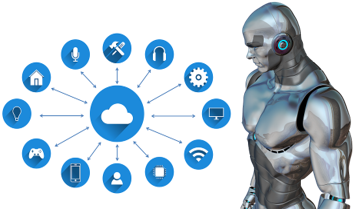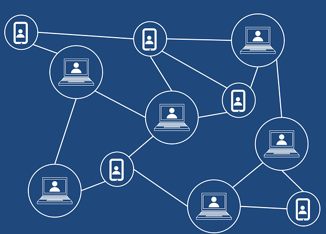What Is Web3.0 Crypto?
What Is the History of the Internet?
- Web 1.0 (1991-2004): Users act mainly as the role of consumers of content
In the early 1990s when the Internet was start to spread, the interaction between users and the Internet was in a very early stage, that is, users could only passively browse text, pictures, and short video content. In short, users can just view what the website provides. There is almost no interaction with the Internet at all. In the mid to late 1990s, before the appearance of Google, the Internet was dominated by AltaVista and Netscape. At that time, entrepreneurs just use the Internet to promote their physical company. The sites are "read-only sites", which means you can only search and read information.
- Web 2.0 (2005-present): Web interact with users, users are creators
At present, Web 2.0 is also called "The R&W(Readable &Writable) Network". Users are not only the visitors of the Internet but also the content creators. Due to the advanced technologies of HTML5, CSS3, Javascript, etc., we can make videos, pictures, articles, etc., then post them to the web, such as Facebook, YouTube, and more. A blogebrity can simply post a video to make a restaurant well known, on the contrary, their bad comments can shut them down. The influence of web users is increasing day by day, the time of simply receiving the information has been passed. In short, web 2.0 has made the Internet more democratic.
- Web 3.0(Future): The Internet know more about you
People have different definitions and opinions about Web 3.0. However, there is no such universal agreement. Most people believe the web 3.0 should receive information from the Internet through online applications and websites, with Ai learning human behavior, combining with blockchain technology, and providing users with new information or data. The web is also connected with home devices, wearable devices, etc., which means it connects everything, it is the Internet of Things. Furthermore, people will get more interested in their visual avatars and assets in the visual world.

What Are the Features of Web3.0?
People believe that Web3.0 should be driven by the technology of Semantics Web, AI, 3D Graphics, and Blockchain.
- Semantic Web: The concept is coined by Tim Berners-Lee, described as a component of Web 3.0. The semantic web is machine-readable, which enables content managers to add meaning to the content, for example, to further describe the meaning of the knowledge. In this way, a machine can process knowledge itself, instead of text, using processes similar to human deductive reasoning and inference, thereby achieving more meaningful consequences. It will help computers to act information gathering and research automatically. With the advantages of directly and clearly expressing the semantic relationship of concepts, simulating human semantic memory and association, and can be used for retrieval and reasoning with high efficiency, it will enhance the connection between humankind and data in Web3.0. Therefore, the user experience will evolve to another level of connectivity.
- AI: Artificial intelligence will filter through the website and provide better data for users. In web 3.0, the Ai will be much more progressive than the era of Web 2.0, which means it will distinguish data much smarter and sift different and suitable data for each user, reduce biased reviews, rigged information. Search engines in the Web 3.0 era will return more personalized results based on your search context.
- 3D Graphics: 3D Graphics will be widely used in Web3.0. Nowadays, metaverse games such as Decentraland, Sandbox, 3D Graphics technology are widely used. People will dive into the visual 3D world on web 3.0.
- Blockchain: In web 2.0, most of the Internet services are provided by centralized services, your data are stored in the central services, dominated by service providers. However, in web 3.0, with the help of blockchain technology, the centralized servers will be replaced with information present on multiple devices. Web 3.0 will be a peer-to-peer internet with no single authority.
Apart from the technical elements, Web 3.0 requires a new revolution to subvert the current monopoly of Internet giants and protect the interests of each Internet user. Thanks to the blockchain technology of decentralized storage, anti-tamper, and information encryption. The real web 3.0 will have the following features:
- Unified identity authentication system
- Data confirmation and authorization
- Privacy protection and anti-censorship
- Decentralized operation
Everyone can participate in the voting, get dividends, and interact between developers and users. That is, we can play games to earn money and decide the future of the community. Web 3.0 will bring the economic model of transparency and democracy.

How Does Blockchain and Crypto Work in Web3.0?
As we all know, the key features of blockchain and cryptography are immutable, secure, and decentralized. With these unique features, blockchain and crypto will solve lots of issues that exist in web 2.0 and create a different world. It is the key to the new era of Web 3.0.
- Blockchain and crypto will help to make Web 3.0 decentralized
Nowadays, the platforms such as Google, Facebook, Amazon, and Twitter came up to make our life easier, at the same time, they are making the rules of the Internet. Some critics have mentioned that these companies will gain too much power and dominate people's daily life because they can access all the users' data. Web 3.0 may try to acquire some of the power and rights back for the users. When blockchain technology is used to create dapps, it is a kind of bookkeeping where many computers at once host data without a central server. The dapps are operated by users collectively, instead of a corporation. People hold tokens to participate in community management, vote for decisions. Thanks to blockchain, people can control their own data and just use one account to get access to all the social media or others dapps.
- Blockchain and crypto will help to build a transparent and trustworthy economic system for Web 3.0
In Web 2.0, we have signed the "User Agreement" and "Privacy Agreement" and never take it as a big deal, then the websites and apps will use our personal data to earn profits and never share the profits with users. As a matter of fact, it is not fair because the users also have the right to obtain the remaining profit after the income covers the operating cost. This problem can be solved through the application of blockchain technology, by data verification and authorization, the third party can not use the user's data if they haven't obtained the authorization. What's more, everyone may get a share of the benefits generated by the use of personal data. For example, we can get tokens while watching an advertisement or playing online games. These kinds of token economies in the digital encryption currency industry will be built in Web 3.0.
- Blockchain guarantees the security of Web 3.0
In Web 1.0 and Web 2.0, people have quite low control right towards their data. For example, you published an article on a forum, one day the forum may shut down and your article will be deleted. Or the online game may be disconnected foreign because of the broke of the game company, everything you win through battles will disappear. Decentralized will solve this problem easily. Blockchains such as Ethereum 2.0 will provide basic computing services for developers. User data can be decentralized storage through IPFS, Sia, OrbitDB. All of the activities are recorded on the blockchain which cannot be tampered with. No one can control your data anymore.

What Are the Web3.0 Crypto Projects?
Today, many crypto projects can be seen as the component of Web 3.0. This article will list some of the popular web 3.0 crypto projects for you to reference.
Polkadot is a completely decentralized platform for Web3, connects private and consortium chains, public and permissionless networks, oracles, and future technologies. Polkadot aims to make a revolutionary impact on blockchain addressing real interoperability, easier creation, greater transactional scalability, and a more secure environment.
Filecoin is an open-source and decentralized cloud storage marketplace, protocol, and cryptocurrency, aims to store humanity's most important information. It is a peer-to-peer network with built-in economic incentives. It may be the important storage part of Web3.0.
Kusama is an experimental community research and development network, built using nearly the same codebase as Polkadot. Kusama is a proving ground for runtime upgrades, on-chain governance, and parachains for developers.
Kusama aims to provide an experimental development environment for teams who want to move fast and innovate on Kusama, or prepare for deployment on Polkadot.
BitTorrent File System is both a protocol and network implementation that provides a p2p mechanism for storing and sharing digital content in a decentralized filing system. BTFS is a decentralized file storage system supported by millions of BitTorrent user nodes. By running on the blockchain, which has a Delegated proof of Stake method of processing blockchain transactions, BTFS addresses these limitations. BTFS represents the first decentralized storage system that can be used by decentralized application (DApp) developers. Soon, BTT will be introduced into the BTFS ecosystem to incentivize a fair and abundant file system.
Closing Thoughts
Web 3.0 is actually fair to everyone. In fact, the application of Web 3.0 has already been used in the financial field. Users can collateral digital assets for stable coins on a decentralized financial platform. The smart contract of financial platforms treats everyone equally. It just knows the digital assets recorded on the chain. On the opposite, in real life, you may use your communication skill to get the loan, however, it is not working on Web 3.0. Blockchain, just like a machine, without feelings, emotions, will not cheat anyone and cannot be cheated. However, the problem still exists in Web 3.0: Low efficiency and a long way to popularize. It is well known that decentralized networks are slow in processing tasks. The popularization of Web 3.0 may be very difficult. Especially in an era when all countries and regions around the world are trying to strengthen Internet supervision. One thing is for sure, from the perspective of decentralization and protection of privacy, Web 3.0 has its value. But its value needs to be tested by the market.
Follow us at: https://www.coincarp.com/learns/
Comments
Post a Comment